Experimental aircraft Northrop MX-324 and MX-334 (USA)
In the course of testing the first experienced “flying wings” of the Northrop brand, it was found that such a scheme gives the aircraft a large lifting force, and in addition, provides a rather high maneuverability. Such features of an unusual scheme could be used to create a promising fighter. There was also a proposal to equip such an aircraft with a jet engine. Such a power plant made it possible to combine high maneuverability with high flight speed.
By the beginning of 1943, Jack Northrop and his colleagues had worked out a preliminary version of the design of a jet fighter built according to the “flying wing” scheme. This project proposed the construction of a medium-sized aircraft equipped with its own turbojet engine. At takeoff, a pair of solid fuel boosters should be used for 1000 pounds, discharged after the fuel was used up. Attacking targets was planned using a set of large-caliber machine guns or other barreled weapons, similar to those used on fighters of the time.
In January 1943, a preliminary draft was shown to representatives of the US Army Air Corps. The military became interested in the new proposal, and soon an order appeared to continue the work. The approved plan meant the development, construction and testing of several new machines with different configurations and differing capabilities.
A promising project received the official "army" designation XP-79, indicating its experimental nature and belonging to the fighter aircraft. Nortrop used its own working title Project 12. In addition, several new designations soon appeared. Thus, an experienced glider of the new design was called the MX-324, and a full-fledged jet aircraft was designated as the MX-334. Finally, the new fighter planned to develop under the name MX-365. The proposal to use a rocket engine led to the fact that some cars of the family received the nickname Rocket Wing (“Rocket wing”).
In accordance with the approved plan, the tests should begin with blowing and flying around gliders that do not have their own propulsion system. Further, it was planned to bring two or three prototype planes to the checks, which could have different configurations. Based on the experience and information obtained during the testing of the MX-324 gliders and the MX-334 prototypes, it was possible to create a full-fledged fighter for the armed forces.
To obtain the maximum possible flight characteristics of a prospective fighter had to have a number of characteristics. So, it was proposed to use the wing with minimal protruding units. At the same time, however, for sufficient road stability, the car should have been equipped with a full keel. Along with other issues, the ergonomics of the cockpit was worked out at the preliminary survey stage. The increased maneuverability of the aircraft was directly related to the increase in overloads. The negative impact on the pilot decided to reduce due to its correct location. According to the original idea of the designers, the XP-79 pilot was supposed to lie on his stomach.
The first MX-324 project implied the construction of an all-metal airframe, most closely resembling the future experimental MX-334 aircraft and a full-fledged combat vehicle. However, the project did not provide for the use of its own power plant or retractable landing gear. Despite such features of the airframe project, already during its development certain ideas and solutions were created and implemented, which subsequently remained on all the machines of the family.
All aircraft of the 12 Project were supposed to be a large wing, supplemented by several external devices. The design was based on a metal frame covered with sheet metal or canvas. The contours of the aircraft were as smooth as possible and differed by a minimum of projecting parts.
The center section of the "flying wing" of the new design served as the fuselage. At the same time, he had a minimal cross section, due to which he almost did not protrude beyond the limits of the main wing. Before the toe of the wing there was a significant head fairing, which served as a cabin lantern. Due to the specific layout of the cabin, it was necessary to use a developed nasal glazing, which provided a good overview of the front hemisphere. Behind such a lantern, the center section gradually reduced its height, merging with the wing in the tail section.
In the tail section of the center-section there was a short tail boom, which slightly protruded beyond the rear edge of the wing. This unit was designed for mounting the arrow-shaped keel, which did not have its own rudder. Under the tail boom there was a small additional comb.
Carrying planes were developed with a swept front edge and a slight back sweep. The root of the trailing edge was given under the installation of flaps, while throughout the rest of the wing span, elevons were located. Under the wing tips were small protrusions-ridges. In connection with the reduction of the dimensions of the rudimentary fuselage, the wing was planned to be given for the installation of certain units.
The MX-324 glider had to be equipped with a four-wheeled chassis. He immediately received two nasal wheels located on the sides of the pilot's cabin. The main wheels were at the center of gravity level and secured under the consoles. It is curious that at least one experienced glider received a combined wheel-ski chassis. A frame with skis was mounted directly on the bottom, and wheels were mounted on the latter.
An experienced glider received a single cabin characteristic layout. There was soft flooring on her floor, which facilitated the work of the pilot. A special rigid base with soft upholstery was placed under the pilot’s chest and neck. In front of the cabin was a control knob, in the rear - the pedals. It was proposed to fly the flight in almost the same way as in the case of some previous J. Northrop planes. The handle was connected to the elevons, and the pedals controlled the tail guards. It was proposed to get into the cabin using a pair of hatches in the upper and lower parts of the wing.
MX-324 in its size roughly coincided with the future fighter XP-79. The wing span was almost 11 m, the length was about 4,3 m. The height was more than 2 m. The glider’s take-off weight slightly exceeded 1 t, which allowed it to be towed by various existing aircraft.
At the end of January 1943, Northrop completed the construction of the first experienced glider. Soon he was sent to one of the research centers for purging in a wind tunnel. Only after such checks was the glider approved for flight tests. At the end of the winter of the same year, the car was first lifted into the air. Soon the second MX-324 joined the tests.
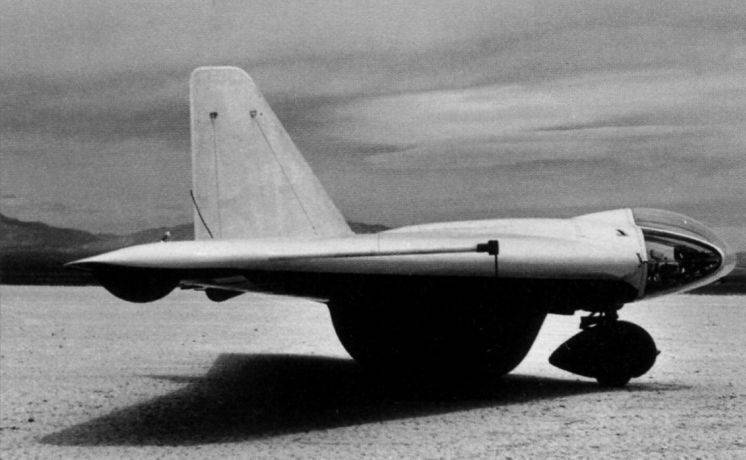
Rocketplane side view. Photo Aviadejavu.ru
Checks gliders in the wind tunnel and in the air showed compliance with the actual performance of the calculated. Taking off in tow, the gliders could go on an independent free flight and carry out the existing flight program. They easily performed maneuvers in speed and altitude, performed various aerobatic maneuvers, etc. At the same time, however, there were some limitations directly related to the absence of the power plant.
October 2 1943, the MX-334 aircraft, rebuilt from the third glider, first flew into the air for the first time. However, this machine also had to take off with the help of a towing vehicle. The fact is that by the time of the construction of the first full-fledged aircraft of the new type, Aerojet, which was responsible for creating the power plant, did not have time to complete all the required work. As a result, the prototype was left without an engine, and over the next few months actually remained the third experienced glider.
The MX-334 project implied the use of the Aerojet XCALR-2000A-1 liquid jet engine with 91 kgf thrust. To simplify the take-off and certain savings of liquid fuel in the tanks, it was proposed to use solid fuel boosters of sufficient power. They should be dumped after fuel generation and take-off. The main rocket engine was distinguished by high fuel consumption, and therefore the aircraft’s built-in tanks could ensure its efficiency only for 210 seconds. After that, the pilot would have to go into a flight planner.
The jet engine was placed in the tail section of the center section; its nozzle was removed in the corresponding opening of the trailing edge of the wing. Under the placement of tanks gave some volumes of the wing, located near the center of gravity. Rapid fuel and oxidizer consumption should not have a negative effect on the alignment of the aircraft.
To reduce air resistance and a certain increase in flight characteristics, a new chassis was used. Placement of the main wheels remained the same, but now they were installed on their own racks. The right nose wheel was removed, leaving only the left on a separate support. No means of cleaning racks were provided. Subsequently, one of the built prototypes received advanced chassis covers. The front desk was covered with a drop-shaped fairing, the main ones - with an elongated trapezoidal shape.
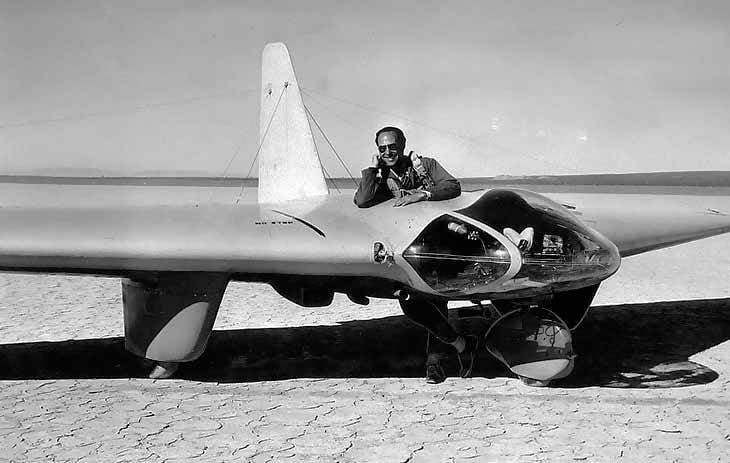
The test pilot demonstrates the presence of two hatches for landing. Photo Zonwar.ru
Tests of aircraft without engines continued for several months. Only in the early summer of 1944, the manufacturer received the first product XCALR-2000A-1, suitable for installation on equipment. The liquid engine and fuel tanks were mounted on one of the available MX-334, after which a new test phase was launched. The first take-off of a jet plane using its own power plant and solid-fuel accelerators took place on June 23. Despite all the difficulties and problems with the supply of components, the Northrop MX-334 was able to get ahead of other samples of its time and become the first American rocket-glider to successfully take to the air.
Probably, by the time the MX-334 began to fly independently, it became clear that liquid engines — especially existing ones that are characterized by high fuel consumption at low loads — cannot be used in new projects. However, not the most advanced engines allowed to study the various features of advanced aircraft.
The MX-334 flight tests in the rocket-plane configuration continued for several weeks and were completed in August of the 1944 year. During this time, the specialists of the company "Northrop" and the Air Corps collected all the necessary information, which previously could not be obtained due to the absence of the engine. All the main features of the design, proposed for use in the design of the fighter, have been tested in practice. Now designers and scientists could return to the drawings and calculations.
The MX-324 gliders and MX-334 airplanes testing program was completed at the end of the summer of 1944, and was very successful. Despite all the difficulties and limitations of a technical nature, several experienced machines were able to show all the necessary qualities and allowed to accumulate a significant amount of data. The information obtained during the tests soon led to some processing of the main project MX-365 / XP-79. According to the results of the tests, certain adjustments were made to the already formed appearance of the fighter.
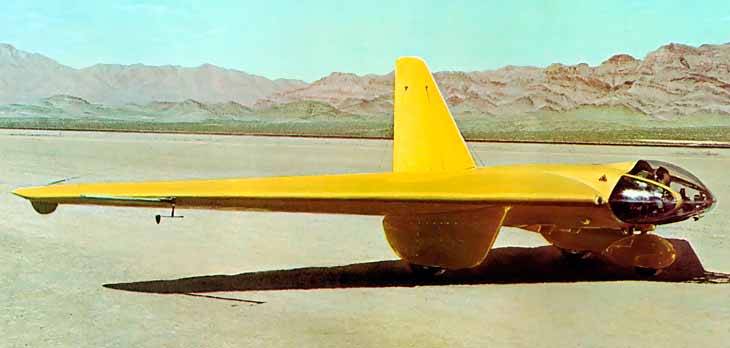
Rocket plane on the airfield. Photo Zonwar.ru
Probably the main consequence of the pilot project was the rejection of the idea of using a liquid-propellant rocket engine. Jet MX-334 took on board the fuel and oxidizer only 3,5 minutes of flight, which could not suit the military. Acceptable flight duration could only be obtained using a turbojet power plant. Non-standard placement of the pilot led to some difficulties, but, in general, gave positive results. The unusual aerodynamic scheme has already been tested in several previous projects and therefore did not cause any complaints.
Due to the impossibility of using a liquid-propellant rocket engine, J. Northrop and his colleagues were forced to rework the existing XP-79 / MX-365 project. In addition, taking advantage of this opportunity, they made the most noticeable changes to the appearance of the fighter. For example, the airframe design was proposed with the maximum possible use of carrier cladding. A new version of the project of the fighter, built according to the “flying wing” scheme, was designated XP-79B. This machine was put to the test in the fall of 1945, and became one of the most interesting developments in stories early fighter aircraft projects. The appearance and other features of this fighter were so unusual that it should be considered separately.
On the materials of the sites:
http://airwar.ru/
https://militaryfactory.com/
http://aviadejavu.ru/
https://aviarmor.net/
http://nationalmuseum.af.mil/
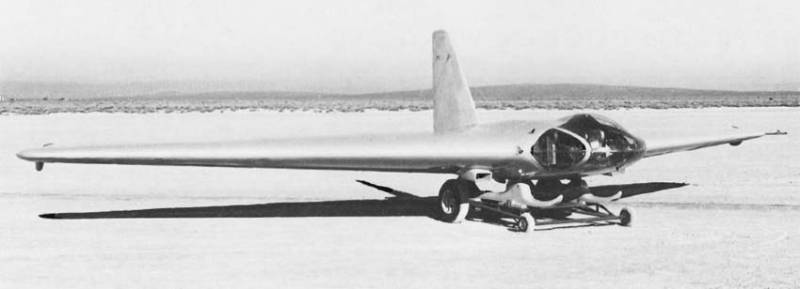
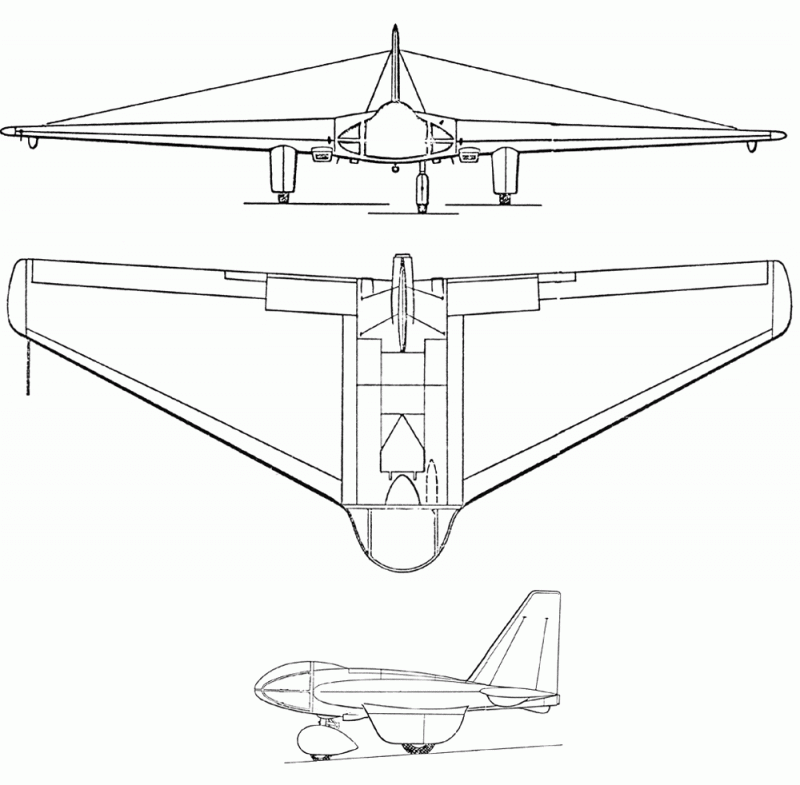
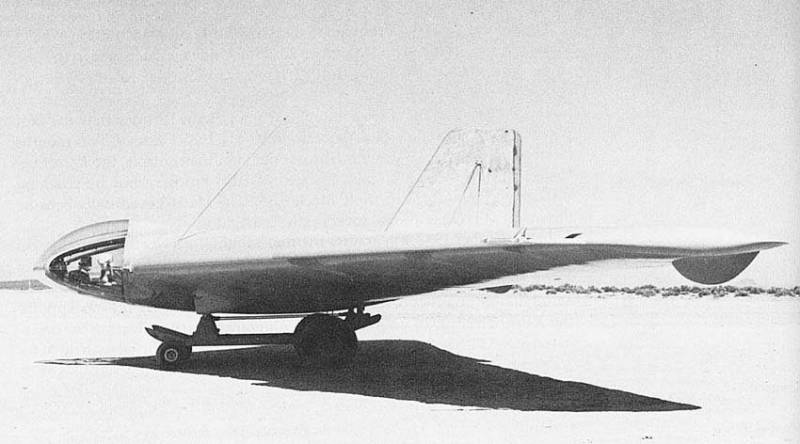
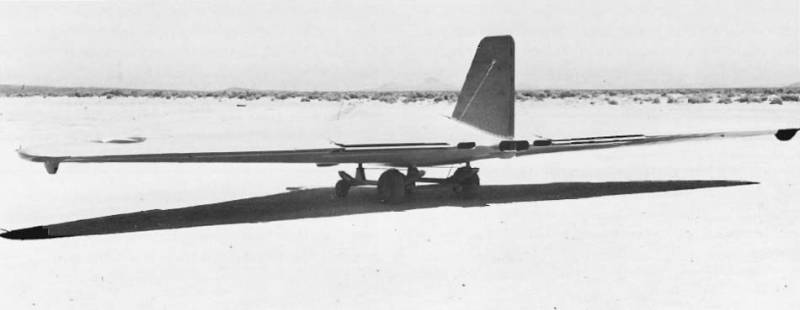
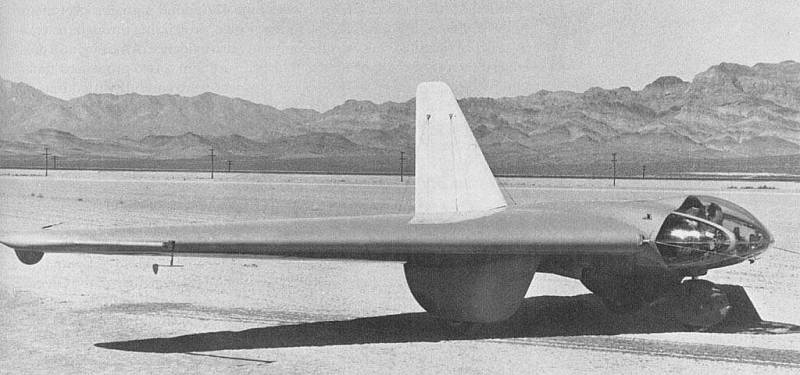
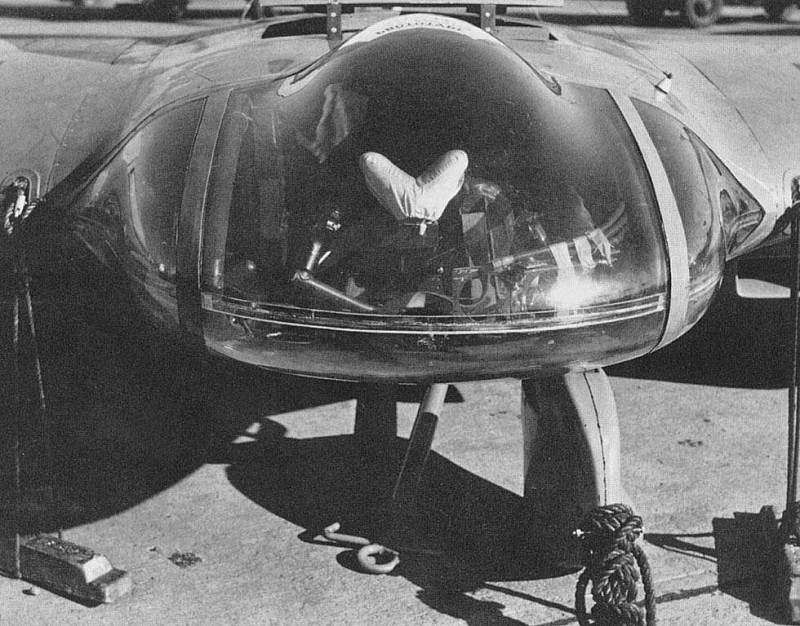
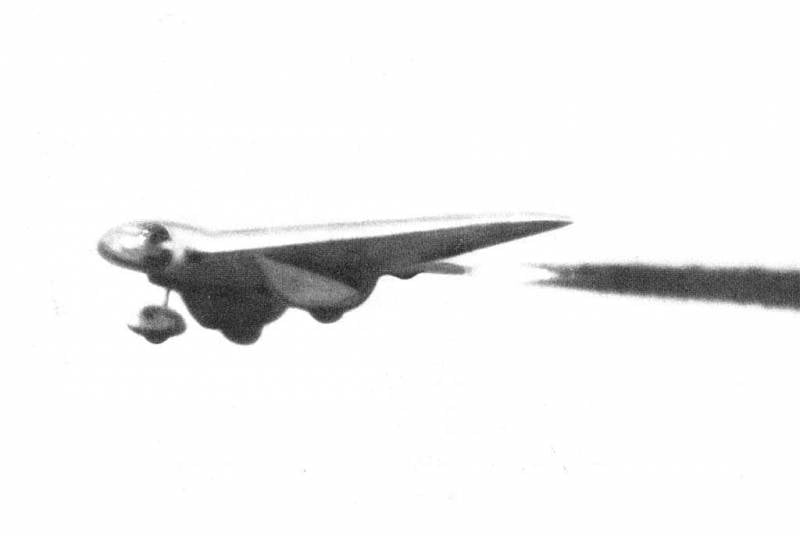
Information